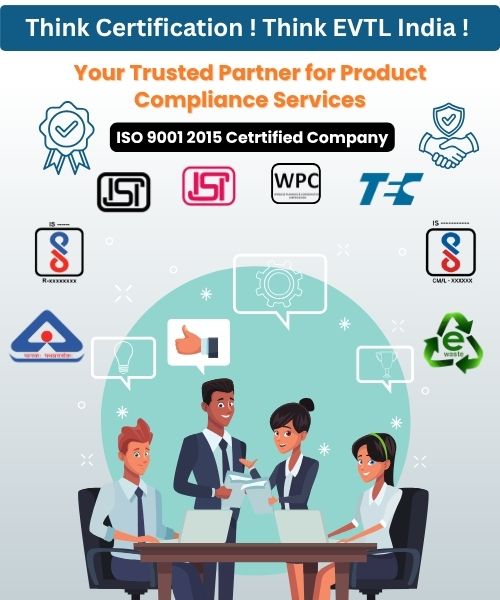Get A Quote
EMI/EMC Testing
Are you an electronic device manufacturer seeking seamless EMI/EMC testing for your products? Look no further—EVTL India is here to simplify the process for you. We provide hassle-free EMI/EMC testing services, ensuring your products meet all regulatory compliance requirements. Our expert team is available 24/7 to assist with all your compliance needs.

- Overview
- What is Electromagnetic Interference (EMI)?
- What is Electromagnetic Compatibility (EMC)?
- Sources of Electromagnetic Interference (EMI)
- Importance of EMI/EMC Testing
- Regulatory Guidelines for EMC Testing
- Measuring and Monitoring EMC
- Common Applications for EMI/EMC Testing
- EMC Testing Routines
- EMI/EMC Testing Products
- Conclusion
- Frequently Asked Question (FAQ)
EMI/EMC Testing - Overview
In today’s interconnected world, electronic devices must coexist without interfering with one another. Electromagnetic interference (EMI) and electromagnetic compatibility (EMC) are essential concepts in ensuring that electronic devices function correctly in shared environments. EMI refers to the disturbance caused by electromagnetic energy emitted by one device, which affects the performance of another device. EMC, on the other hand, is the ability of a device to operate without affecting or being affected by other devices in its environment.

EMI and EMC testing are crucial to ensure that products meet regulatory standards, function efficiently, and do not pose risks in various industries such as medical devices, consumer electronics, aerospace, and military systems. This article provides an in-depth look at EMI/EMC testing, its importance, the testing process, and the different types of equipment involved.
What is Electromagnetic Interference (EMI)?
Electromagnetic Interference (EMI) refers to the unwanted electromagnetic energy that disrupts the normal functioning of electronic devices. Any electronic device can emit electromagnetic radiation, which can interfere with other devices in its proximity. EMI can occur naturally, such as through electrical storms or solar radiation, but more commonly, it is caused by other electronic equipment. For example, devices like cell phones, motors, welders, and LED screens are known to generate high levels of EMI.
Devices rarely operate in isolation, so they are often designed to function despite the presence of some electromagnetic interference. However, excessive EMI can lead to performance degradation or even complete failure of critical equipment, particularly in sensitive sectors like avionics and military systems.
What is Electromagnetic Compatibility (EMC)?
Electromagnetic Compatibility (EMC) is the ability of a device to operate as intended in its environment without generating or being affected by electromagnetic interference. EMC testing is critical to ensure that devices are immune to EMI while also ensuring that they do not emit excessive electromagnetic noise that could affect other devices.
EMC testing is divided into two categories:
Sources of Electromagnetic Interference (EMI)
EMI can be caused by various sources, ranging from environmental factors to other electronic devices. Some common sources include:
Because modern electronic devices often operate in close proximity to each other, managing EMI is critical, especially in industries requiring reliable and uninterrupted performance, such as healthcare, aerospace, and telecommunications.
The Importance of EMI/EMC Testing
EMI/EMC testing is essential for several reasons:
Because modern electronic devices often operate in close proximity to each other, managing EMI is critical, especially in industries requiring reliable and uninterrupted performance, such as healthcare, aerospace, and telecommunications.
Regulatory Guidelines for EMC Testing
Various regulatory standards govern the levels of electromagnetic interference a device can produce and how much electromagnetic noise it can tolerate. These standards include:
- FCC Part 15: Defines limits for unlicensed radio frequency interference in consumer electronics in the United States.
- MIL-STD 461 and MIL-STD 464: Military standards for EMC, outlining specific requirements for both subsystems and complete systems.
- ISO, IEC, CISPR Standards: International standards define acceptable EMI and EMC limits. Compliance with these standards is required in many industries to ensure that devices are safe and reliable.
For industries like aerospace, healthcare, and consumer electronics, meeting these regulatory guidelines is critical to product safety and marketability.
Measuring and Monitoring EMC
To ensure a device meets the required standards, a range of EMI/EMC testing equipment is used. Testing usually involves:
Emissions Testing: This uses receiving antennas, amplifiers, and spectrum analyzers to measure the electromagnetic noise a device generates. Testing can be done in open area test sites or shielded anechoic chambers to isolate external noise.
Immunity Testing: This assesses a device’s ability to tolerate electromagnetic noise from external sources. Equipment used includes signal generators, power amplifiers, and simulators to recreate different types of electromagnetic disturbances, such as power surges and voltage drops.
A combination of these tools helps engineers assess whether a product can operate as intended in real-world environments.
Common Applications for EMI/EMC Testing
Medical Devices: In healthcare, devices must work together in close quarters without interference. Regulatory bodies like the FDA and the European Union require medical devices to undergo EMC testing, particularly under standards such as IEC 60601-1-2.
Military and Aerospace: EMC testing for military and aerospace equipment must meet stringent standards like MIL-STD 461. These devices often need to function in high-stress environments, making immunity to EMI crucial for operational safety.
Consumer Electronics: Devices like microwaves, mobile phones, and laptops must undergo EMC testing to ensure they do not emit harmful interference and can function properly in the presence of other electronic devices.
Conducted and Radiated Noise: Both forms of electromagnetic noise are tested to ensure devices can handle disturbances.
Testing labs typically use specialized equipment such as surge generators, spectrum analyzers, and power amplifiers to simulate these conditions and evaluate device performance.
EMC Testing Routines
EMC testing is not a one-size-fits-all process. The specific testing routine depends on the type of device, its intended application, and the regulatory requirements it must meet. Common phenomena simulated in EMC testing include:
- Magnetic Fields: Testing simulates the effect of electromagnetic fields radiating from wires.
- Power Interruptions: Devices are tested for resilience to voltage drops and brownouts.
- Electromagnetic Surges: The ability to handle surges caused by lightning or other sources is tested.
For industries like aerospace, healthcare, and consumer electronics, meeting these regulatory guidelines is critical to product safety and marketability.
EMI/EMC Testing Products
Pre-compliance EMC testing is recommended to identify potential issues early in the product development process. Companies like Com-Power Corp. manufacture a variety of equipment for EMI and EMC testing. This equipment includes antennas, amplifiers, and spectrum analyzers designed to detect electromagnetic interference and measure compatibility.
Testing during the design phase helps engineers resolve issues before formal testing begins, saving time and resources. Com-Power also offers complete pre-compliance testing packages that allow companies to perform testing in-house.
Conclusion:
EMI/EMC testing is essential for ensuring the safety, reliability, and regulatory compliance of electronic devices. By testing devices for emissions and immunity to electromagnetic interference, manufacturers can prevent device malfunctions and ensure compatibility in diverse operating environments.
EVTL India simplifies the EMI/EMC testing process, offering comprehensive support to help organizations achieve hassle-free compliance. Our team assists with regulatory guidance, testing procedures, and equipment setup, ensuring your product meets the necessary standards efficiently.
Frequently Asked Questions (FAQ)
Our Services
Testimonials
News & Updates









